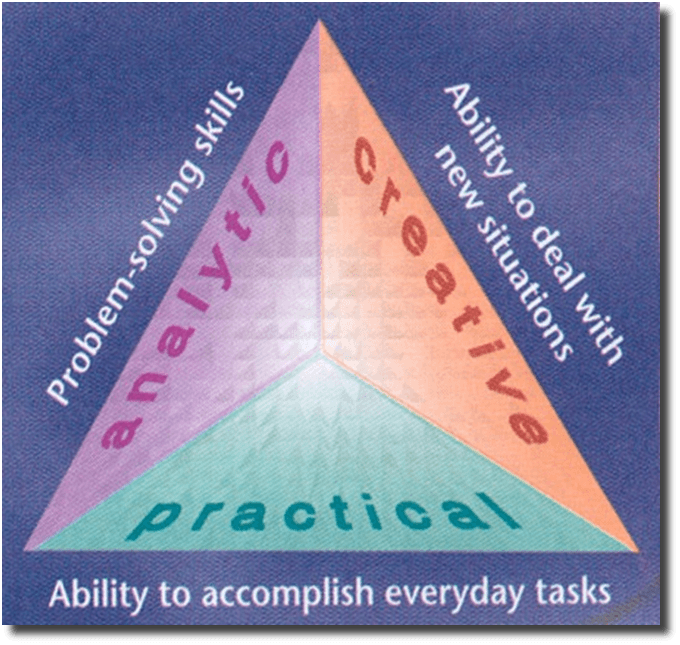This theory of intelligence relies on the sensitivity to other people’s feelings and the ability to respond to them.
What is emotional intelligence?
Note: either Daniel Goleman's Emotional Intelligence or Howard Gardner's multiple intelligence theory "interpersonal" is acceptable as an answer.
This score is calculated using the following formula:
Mental age
------------------------ X 100
Chronological age
What is Intelligence Quotient?
Name one career someone with strong musical intelligence would be successful in.
What is a...
Musician, Singer, Conductor, Composer, Songwriter
About half of the people who take the Wechsler tests score:
a. above 130.
b. below 70.
c. between 90 and 110
d. between 70 and 130
c
This area deals with spatial judgement and the ability to visualize with the mind's eye. Careers which suit those with this type of intelligence include artists, designers and architects.
What is Spatial Intelligence?
This term describes a test’s consistency (does it give similar scores every time?).
What is reliability?
Name one study strategy for a kinesthetic learner.
What is...
assembling charts, taking a walk while studying, building a model, etc
This shape describes the distribution of IQ scores on a graph.

What is a bell curve?
(What is a normal curve?)
Over 100 years ago, Charles Spearman suggested that all the behaviors we consider to be intelligent have a common underlying factor. These two factors were named in his theory.
SECRET BONUS QUESTION: Double your points by explaining each of the two factors.
G factor = general intelligence, or abilities to reason & solve problems.
S factor = specific factors that account for particular abilities.
Problems with IQ tests: some test takers do better than others, but not necessarily because they are more intelligent. Name two potential reasons.
Sample answers: differing education, economic background, motivation, cultural bias.
This kind of learner would enjoy studying in groups.
What is an interpersonal learner?
Backwards Jeopardy!!! (Is that just... a normal question...?)
What is test-retest reliability?
The comparison of test scores from a person taking the same (similar) tests at different times.
This area has to do with introspective and self-reflective capacities. This refers to having a deep understanding of the self; what your strengths/ weaknesses are, what makes you unique, and being able to predict your own reactions/emotions.
What is Intrapersonal Intelligence?
Robert Sternberg developed this theory that sees intelligence as comprised of three parts. Name the theory.

What is the triarchic theory of intelligence?
Fill in the blanks:
Tests designed to predict your ability to learn something new are called a__________________ tests. Tests designed to measure what you have already learned are called a___________________ tests.
aptitude, achievement
Name two strategies that visual-spatial learners may use when acquiring new information.
What is...
sketching pictures to go along with notes, using charts/tables/diagrams/organizers, visualizing images and scenarios which associate with different concepts or ideas, and making visual flash cards
Describe the level of intellectual disability of a person with an IQ score of 40-55 (most in this range do not learn to read or do math).
a. mild
b. moderate
c. severe
d. profound
b.

SECRET BONUS ROUND! Each group can provide a different answer to this question for 500 points (starting with the group that picked). Your answer does not have to be in the form of a question.
According to Gardner a person could be intelligent musically or athletically. Critics however may say that these people have skills & talent - not intelligence. Why is that?
Sample answers: they may not do well in school, those traits do not help with a job, they would not score well on a standard IQ test, etc.
This type of intelligence, though not officially adopted by Gardner, is considered a "promising candidate." It can be referred to as the intelligence based on the "human proclivity to ponder the most fundamental questions of existence."
What is Existential Intelligence?
American psychologist, Louis Thurstone, believed that seven separate factors make up intelligence. He called them primary mental abilities. Name three of these factors.
What are...
Visual & Spatial relations
• Perceptual speed
• Numerical ability
• Verbal comprehension
• Memory
• Word fluency
• Deductive reasoning & Inductive reasoning
Both the Stanford-Binet and Wechsler scales involve verbal skill assessment. The Wechsler scales differ from the Stanford-Binet test by also assessing performance skills. Give at least two different examples of a performance task.
Tasks should involve problem solving without words. They include tasks that require understanding the spatial relations & manipulation of materials. Sample tasks: such as assembling blocks, solving mazes, completing pictures, ordering pictures of a scene, etc.
Name three different types of career for a person with a high bodily-kinesthetic intelligence.
What are a/an...
- Athlete
- Dancer
- Mechanic
- Actor / Actress
- Performer
- Physical Education Instructor
- Craftsman
- Physical Therapist
- Farmer
- Carpenter
- Builder
- Park Ranger
- Firefighter
- Paramedic
Though not found to be valid, this effect suggests that listening to complex or playing a musical instrument helps other cognitive functions such as spatial reasoning.
What is the Mozart effect?